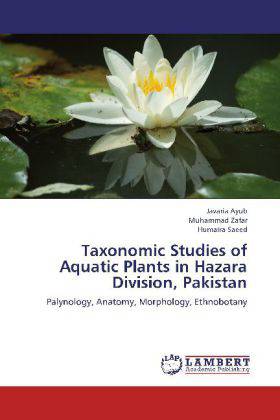
- Afhalen na 1 uur in een winkel met voorraad
- Gratis thuislevering in België vanaf € 30
- Ruim aanbod met 7 miljoen producten
- Afhalen na 1 uur in een winkel met voorraad
- Gratis thuislevering in België vanaf € 30
- Ruim aanbod met 7 miljoen producten
Zoeken
Taxonomic Studies of Aquatic Plants in Hazara Division, Pakistan
Palynology, Anatomy, Morphology, Ethnobotany
Javaria Ayub, Muhammad Zafar, Humaira Saeed
Paperback | Engels
€ 77,45
+ 154 punten
Omschrijving
The present book investigate the morphological, palynological, anatomical features and ethnobotanical profile of 23 species of aquatic plants belonging to 17 families of Hazara Divison, Pakistan. The objective of the study was to identify and classify the plants on the basis of above mentioned studies and to study the intraspecific, intrageneric and intergeneric relationships among species. This study was also carried out to highlight the ethnobotanical knowledge including local name, habitat, parts used, medicinal uses and other uses of plants. Among pollens maximum polar size and equatorial diameter was reported in Coix lacryma-jobi L was 83.75 µm and 72.5 µmwhereas the lowest polar and equatorial diameter was observed in Nasturtium officinale R.Br i.e. 17.5 µm and 14.37 µm respectively.Maximum exine thickness was observed in Eclipta alba L 4.37 µm whereas lowest exine thickness was shown by Bacopa monneiri (L.) Pennell i.e 1.62 µm. The highest percentage pollen fertility was reported in Eclipta alba L i.e. 96.29 and the lowest percentage fertility was observed in Eichhornia crassipes (Mart.) Solms i.e. 70.3. The highest trichome length was observed in the abaxial of leaf epider
Specificaties
Betrokkenen
- Auteur(s):
- Uitgeverij:
Inhoud
- Aantal bladzijden:
- 128
- Taal:
- Engels
Eigenschappen
- Productcode (EAN):
- 9783844397055
- Verschijningsdatum:
- 12/12/2012
- Uitvoering:
- Paperback
- Afmetingen:
- 150 mm x 220 mm
- Gewicht:
- 200 g

Alleen bij Standaard Boekhandel
+ 154 punten op je klantenkaart van Standaard Boekhandel
Beoordelingen
We publiceren alleen reviews die voldoen aan de voorwaarden voor reviews. Bekijk onze voorwaarden voor reviews.








